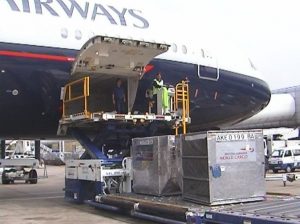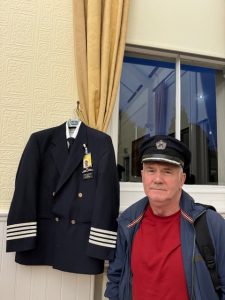
Monthly talk: Gray O’Hanlon – It’s up in the Air!
I was delighted that we had such a good audience for November’s monthly meeting. We welcomed Gray O’Hanlon to talk about his career as a pilot, flying for British Airways as well as other airlines through his long career.
Gray started flying as a result of a scholarship he was awarded at school. He started on the small Piper in Oxford and progressed through the Piper Twin Comanche until he became a pilot on the noisy Trident, then the 757 and on to the 777, also known as the Queen of the Skies.
He gave a fascinating tour of his ‘office’ as he termed the flight deck. (The uninitiated may use the term ‘cockpit’ but this only applies to military aircraft.) To the layman, there is a bewildering array of dials and controls, but Gray helped us to make sense of the key controls a pilot needs to master. The six primary instruments are the Altitude Indicator (AI), Heading Indicator (HI), Turn Coordinator, Airspeed Indicator, Altimeter, and the Vertical Speed Indicator (VSI).
A modern airliner is a remarkable, complex work of engineering. He gave a flavour of the many technical checks required before take-off, including information about weather conditions, the checks that all the systems on board are working correctly – and airports en route should there be a need for an unscheduled landing! For those of us who are usually content to just sit for the duration of the flight and not worry too much about what is required to get us safely to our destination, much of what we learned was a revelation – and certainly very reassuring. From all the checks of ID cards and at flight briefing in British Airways nothing is left to chance. Once passengers are on board the flight deck crew will show the safety procedures. The captain will announce take off and only when at cruising level is the automatic pilot activated. Even then, the captain and co-pilot will remain vigilant that all gauges, dials and setting are as they should be. If you are a captain of a 777, there will be up to 380 passengers who depend upon every decision the captain and co-pilot make.
 Gray illustrated his talk with a number of photos of parts of the plane we only see from a distance. Quite apart from anything else, the sheer size of these machines leaves a powerful impression: enormous engines, tyres, storage spaces for baggage all dwarf the crews who work with the planes.
Gray illustrated his talk with a number of photos of parts of the plane we only see from a distance. Quite apart from anything else, the sheer size of these machines leaves a powerful impression: enormous engines, tyres, storage spaces for baggage all dwarf the crews who work with the planes.
Members had lots of questions. Who owns the Black Box? (It’s not black at all but orange, and is the responsibility of the CAA in the UK.) How do pilots deal with jet lag and adjusting to different time zones? (For the most part Gray assured us that this is not an issue as the return flights do not allow the pilot the time to become accustomed to a different time zone, although planning sleep does become a real challenge.) How long does the training for a pilot take? (Over a year, and retraining is needed whenever a pilot is transferred to a different aircraft.) What proportion of pilots are women? (Perhaps unsurprisingly, a very small proportion of pilots are women. This situation is changing but there is clearly a long way to go.)
Gray’s talk gave us a fascinating insight into the life and work of a pilot, and will add considerable interest to us should we take to the air in future.
John Vick, Khim Sim Tan

